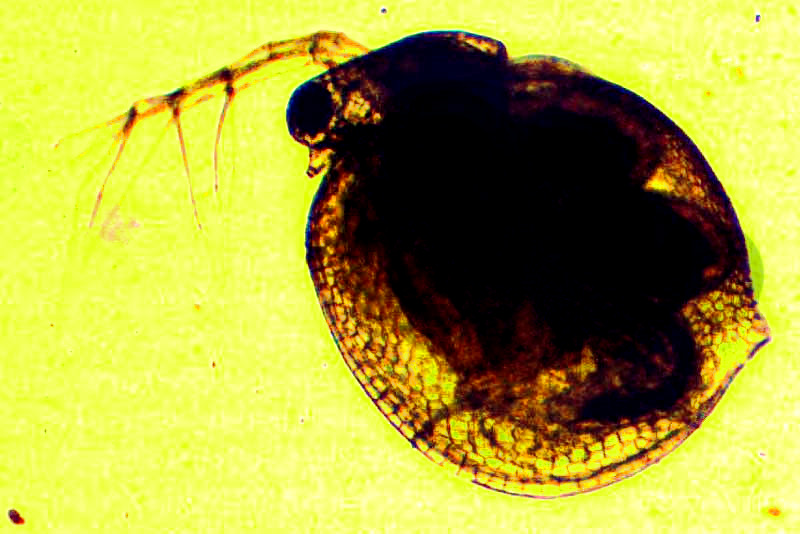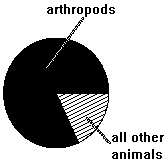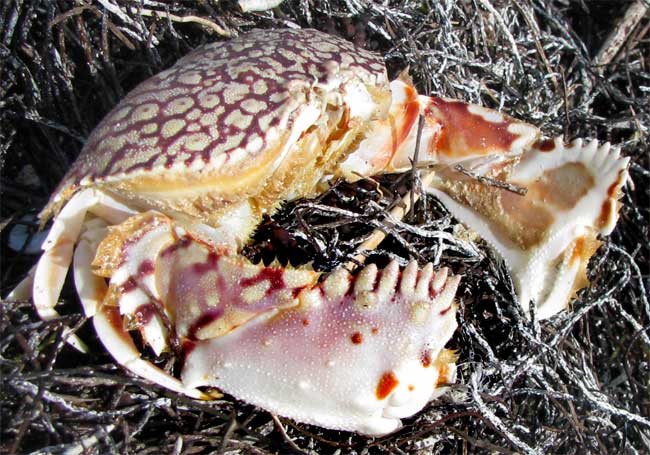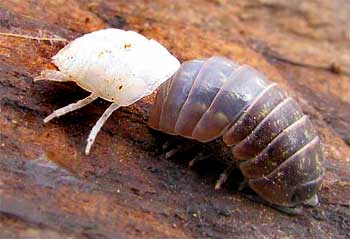
 Joint-legged animals without backbones are called arthropods and are placed in the phylum Arthropoda. Human legs are jointed at the knees, but we have backbones, so we're not arthropods. On the tick at the left you can clearly see the joints.
Joint-legged animals without backbones are called arthropods and are placed in the phylum Arthropoda. Human legs are jointed at the knees, but we have backbones, so we're not arthropods. On the tick at the left you can clearly see the joints.
How do you know this tick isn't an insect? The easiest thing to notice is that insects have 3 pairs of legs (6 of them) while this tick has 4 pairs (8 legs). Also, insects have 3 body regions (head, thorax and abdomen) while this tick appears to just have a head and a body. Both ticks and insects are members of the phylum Arthropoda, but ticks, along with spiders, are members of the class Arachnida, while insects belong to the class Insecta.
Here's a simplified outline showing how the best known kinds of arthropods hang together:
BEST-KNOWN SUBDIVISIONS OF THE ARTHROPOD PHYLUM

Class Arachnida (arachnids )Order Araneae (spiders )Order Opiliones (harvestmen/daddy-longlegs )Order Scorpiones (scorpions )Subclass Acari (mites & ticks )
Class Chilopoda (centipedes )Class Diplopoda (millipedes )
To see a much more complete, and confusing, breakdown, visit the NCBI taxonomy database
Keep in mind that many commonly occurring arthropods are tiny, even microscopic, such as Daphnias, sometimes called water fleas (genus Daphnia). Daphnias such as the one shown below are crustaceans often found in lakes and ponds.

The more than 200 Daphnia species range in size from 0.01 to 0.20 inches (0.2-5.0mm).
ARTHROPODS ARE VERY SUCCESSFUL ANIMALS
 From nature's point of view, the combination of having jointed legs but lacking a backbone seems to be a good one. That's because
From nature's point of view, the combination of having jointed legs but lacking a backbone seems to be a good one. That's because
The word "successful" needs to be defined, for many humans would consider mammals to be earth's most successful group of animals, since humans are mammals, and humans are obviously Earth's "top dogs." However, the human standard for "success" isn't necessarily the only one. From a biological perspective, animal groups are "successful" if...
- they include a large number of species
- the species occupy many different kinds of habitats
- the species eat many kinds of food
- the species are good at defending themselves from their enemies
You can judge for yourself how successfully the Flame Box Crab, Calappa flammea, shown below, might defend itself.

ARTHROPOD EVOLUTIONARY ADVANCES
What makes arthropods so successful? Here are some of the most obvious evolutionary advances that arthropods show over the simpler, more "primitive" mollusks and segmented worms:
- Jointed legs give arthropods more mobility on dry land than legless mollusks and worms
- Arthropod body segments are more specialized than annelid (worms) segments, enabling arthropods to do more than worms and mollusks -- like eat a greater variety of foods and run real fast
- The arthropods' exoskeleton (outside skeleton) reduces water loss from their bodies much better than the annelids' cuticle and the mollusks' thin skin
ARTHROPOD EXOSKELETONS
Exoskeletons -- "outside skeletons" -- are one of "nature's greatest inventions" -- one of the main features responsible for arthropods being so successful. Below you can see a pillbug shedding its old exoskeleton:

Shedding takes place in two stages. First the rear end covering is shed, so in the picture the old exoskeleton is white part at the left of the darker pillbug. The dark pillbug is half covered with its old front covering, which is paler than the rest of the body. That pale covering will be shed next.
If you're a land animal wanting to move around faster than a snail or an earthworm, you need muscles and you need stiffness. Stiffness is important because muscles must be attached to something secure, and the appendages they move must be stiff, or else they'll flop and flap, instead of taking steps, or raising hands or feet. Unskeletonized flesh can artfully ripple, wiggle, and elongate and shorten, but that's nothing compared to a cockroach's ability to skitter across the kitchen floor.
Arthropod exoskeletons serve the same functions as our human skeletons, which are inside-the-body endoskeletons. The question arises, then, "If exoskeletons are so great, why don't humans, birds, fish and elephants have them?"
It happens that, because of the general physics of large and small bodies, endoskeletons work better in land animals over, say, three inches long (7.6cm), while exoskeletons are best for smaller land animals. Anyone who has seen an oversized ripe watermelon burst from being banged around too much knows how fragile rigid coverings are for large, heavy bodies. Also, it's hard to imagine a Ladybird Beetle crammed with the numbers of highly specialized bones a human has.
Moreover, exoskeletons have at least two major drawbacks, even for small animals:
- First, to grow, animals contained within exoskeletons must periodically split through their coverings, then produce new, larger ones to accommodate their larger sizes. During the time between breaking from the old exoskeleton and when the new, larger shell has hardened, the animal is often vulnerable to its predators. The shedding of an exoskeleton or outer layer of skin is referred to as ecdysis.
- The "general physics of large and small bodies" spoken of earlier precludes animals with exoskeletons from growing as large as animals with internal skeletons. Therefore, animals small enough to be well served by exoskeletons can't evolve into species with brains large enough to be creative in the manner that humans are. Future arthropod species seem doomed to live lives guided more by instinct than by reason.